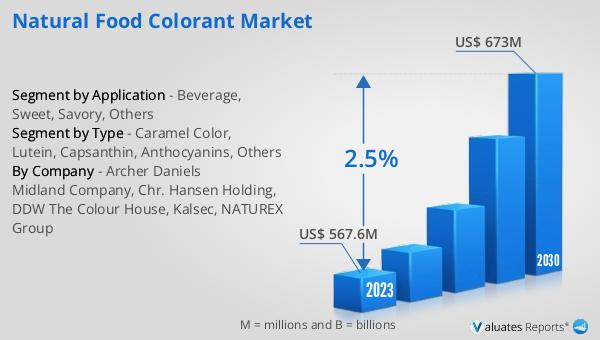What is Global Natural Food Colorant Market?
The Global Natural Food Colorant Market is an intriguing sector that focuses on providing color solutions derived from natural sources for the food and beverage industry. This market is driven by the growing consumer demand for natural and organic products, as people become more aware of the health implications associated with synthetic additives. Natural food colorants are extracted from a variety of sources including fruits, vegetables, plants, and minerals, offering a palette of colors without compromising on safety. These colorants not only enhance the visual appeal of food and drinks but are also perceived to be healthier options compared to their synthetic counterparts. The shift towards clean labels and the push for transparency in food labeling have further propelled the demand for natural colorants. As consumers increasingly prefer products with fewer artificial ingredients, the global natural food colorant market is poised for significant growth, catering to a more health-conscious audience seeking authenticity and quality in their food choices.

Caramel Color, Lutein, Capsanthin, Anthocyanins, Others in the Global Natural Food Colorant Market:
Diving into the specifics, the Global Natural Food Colorant Market is segmented into various types including Caramel Color, Lutein, Capsanthin, Anthocyanins, among others, each playing a unique role in coloring food products naturally. Caramel color, derived from the controlled heat treatment of sugars, is widely used for its rich, warm brown tones in beverages and confectioneries. Lutein, extracted from marigold flowers, offers yellow to orange hues and is favored not just for its color but also for its nutritional benefits, particularly in eye health. Capsanthin, responsible for the vibrant red-orange color in paprika, is used in meats and spices to enhance their color naturally. Anthocyanins, found in a wide range of fruits and vegetables, provide a spectrum of colors from red to blue, depending on the pH level of the product they are added to. These natural colorants are preferred for their dual role of adding visual appeal and potential health benefits, as they often come with antioxidant properties. The market also includes other natural color sources that are continuously being explored and utilized to meet the growing demand for clean label products. This segment's diversity reflects the industry's adaptability and commitment to offering safer, more natural coloring options to consumers.
Beverage, Sweet, Savory, Others in the Global Natural Food Colorant Market:
The application of the Global Natural Food Colorant Market spans across various sectors including Beverages, Sweets, Savory, and others, showcasing the versatility and essential role of natural colorants in the food industry. In beverages, natural colorants are used to make drinks more visually appealing, whether it's giving a soft drink its signature color or enhancing the natural hue of fruit juices. Sweets, such as candies and baked goods, rely on these colorants to attract consumers with their vibrant colors, which can indicate flavor or simply make the product more enticing. In savory applications, natural colorants are used to restore or enhance the appearance of processed foods, making them look more appetizing and fresh. Other areas include dairy products, where natural colorants are used to standardize the color of products like cheese and butter, and in health supplements, where they not only improve product appearance but also align with the health-conscious ethos of the target market. The use of natural colorants in these sectors demonstrates the industry's shift towards more natural, healthier food additives, catering to the growing consumer demand for products free from synthetic dyes and chemicals.
Global Natural Food Colorant Market Outlook:
Regarding the market outlook, the Global Natural Food Colorant Market's value stood at US$ 567.6 million in 2023, with projections suggesting an increase to US$ 673 million by 2030. This growth trajectory, marked by a Compound Annual Growth Rate (CAGR) of 2.5% during the forecast period from 2024 to 2030, underscores the market's robust potential. This anticipated expansion reflects the escalating consumer preference for natural and organic products, which is driving the food and beverage industry towards adopting natural colorants over synthetic alternatives. The market's growth is also indicative of the broader trend towards health and wellness, where consumers are increasingly scrutinizing product labels for natural ingredients. As the demand for clean label products continues to rise, the natural food colorant sector is expected to witness sustained growth, catering to the evolving preferences of health-conscious consumers and the food industry's need for natural, safe, and visually appealing ingredients.
| Report Metric | Details |
| Report Name | Natural Food Colorant Market |
| Accounted market size in 2023 | US$ 567.6 million |
| Forecasted market size in 2030 | US$ 673 million |
| CAGR | 2.5% |
| Base Year | 2023 |
| Forecasted years | 2024 - 2030 |
| Segment by Type |
|
| Segment by Application |
|
| Consumption by Region |
|
| By Company | Archer Daniels Midland Company, Chr. Hansen Holding, DDW The Colour House, Kalsec, NATUREX Group |
| Forecast units | USD million in value |
| Report coverage | Revenue and volume forecast, company share, competitive landscape, growth factors and trends |
